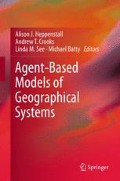Abstract
This chapter provides some general reflections on the development of ABM in terms of the applications presented in this book. We focus on the dilemma of building rich models that tend to move the field from strong to weaker styles of prediction, raising issues of validation in environments of high diversity and variability. We argue that we need to make progress on these issues while at the same time extending our models to deal with cross-cutting issues that define societal grand challenges such as climate change, energy depletion, aging, migration, security, and a host of other global issues. We pick up various pointers to how we might best use models in a policy context that have been introduced in many of the applications presented within this book and we argue that in the future, we need to develop a more robust approach to how we might use such models in policy making and planning.
Access this chapter
Tax calculation will be finalised at checkout
Purchases are for personal use only
Notes
- 1.
ABM is also taken to mean Agent-Based Model (s) as well as Modelling.
References
Axtell, R., Axelrod, R., Epstein, J. M., & Cohen, M. D. (1996). Aligning simulation models: A case study and results. Computational and Mathematical Organization Theory, 1, 123–141.
Banos, A., & Genre-Grandpierre, C. (2012). Towards new metrics for urban road networks: Some preliminary evidence from agent-based simulations. In A. J. Heppenstall, A. T. Crooks, L. M. See, & M. Batty (Eds.), Agent-based models of geographical systems (pp. 627–642). Dordrecht: Springer.
Barros, J. (2012). Exploring urban dynamics in Latin American cities using an agent-based simulation approach. In A. J. Heppenstall, A. T. Crooks, L. M. See, & M. Batty (Eds.), Agent-based models of geographical systems (pp. 571–589). Dordrecht: Springer.
Batty, M. (2010). Integrated models and grand challenges. ArcNews, Winter 2010/2011. Available at http://www.esri.com/news/arcnews/winter1011articles/integrated-models.html. Accessed 16 June 2011.
Castiglione, F. (2003, November 3–6). Large-scale agent-based models: Perspectives and requirements, hot topics. Workshop: Agent Based Modeling and Simulation, The Institute for Mathematics and its Applications, University of Minnesota. Available at http://www.ima.umn.edu/talks/workshops/11-3-6.2003/castiglione/IMA-WrkshpABM2003.pdf. Accessed 16 June 2011.
Epstein, J. M. (2008). Why model? Journal of Artificial Societies and Social Simulation, 11(4), 12. Available at http://jasss.soc.surrey.ac.uk/11/4/12.html. Accessed 16 June 2011.
Greenberger, M., Crenson, M., & Crissey, B. L. (1976). Models in the policy process: Public decision making in the computer era. New York: Russell Sage Foundation/Basic Books.
Gulden, T. R., & Hammond, R. A. (2012). Beyond Zipf: An agent-based understanding of city size distributions. In A. J. Heppenstall, A. T. Crooks, L. M. See, & M. Batty (Eds.), Agent-based models of geographical systems (pp. 677–704). Dordrecht: Springer.
Harland, K., & Heppenstall, A. J. (2012). Using agent-based models for education planning: Is the UK education system agent based? In A. J. Heppenstall, A. T. Crooks, L. M. See, & M. Batty (Eds.), Agent-based models of geographical systems (pp. 481–497). Dordrecht: Springer.
Iltanen, S. (2012). Cellular automata in urban spatial modelling. In A. J. Heppenstall, A. T. Crooks, L. M. See, & M. Batty (Eds.), Agent-based models of geographical systems (pp. 69–84). Dordrecht: Springer.
Johansson, A., & Kretz, T. (2012). Applied pedestrian modeling. In A. J. Heppenstall, A. T. Crooks, L. M. See, & M. Batty (Eds.), Agent-based models of geographical systems (pp. 451–462). Dordrecht: Springer.
Malleson, N. (2012). Using agent-based models to simulate crime. In A. J. Heppenstall, A. T. Crooks, L. M. See, & M. Batty (Eds.), Agent-based models of geographical systems (pp. 411–434). Dordrecht: Springer.
Ngo, T. N., & See, L. M. (2012). Calibration and validation of agent-based models of land cover change. In A. J. Heppenstall, A. T. Crooks, L. M. See & M. Batty (Eds.), Agent-based models of geographical systems (pp. 181–196). Springer.
PACER (2011). National Center for the Study of Preparedness and Catastrophic Event Response (PACER). Available at http://www.orau.gov/dhssummit/factsheet/PACER2011.pdf. Accessed 16 June 2011.
Pumain, D. (2012). Multi-agent system modelling for urban systems: The series of SIMPOP models. In A. J. Heppenstall, A. T. Crooks, L. M. See, & M. Batty (Eds.), Agent-based models of geographical systems (pp. 721–738). Dordrecht: Springer.
Simoes, J. A. (2012). An agent-based/network approach to spatial epidemics. In A. J. Heppenstall, A. T. Crooks, L. M. See, & M. Batty (Eds.), Agent-based models of geographical systems (pp. 591–610). Dordrecht: Springer.
Smith, D. M. (2012). Simulating spatial health inequalities. In A. J. Heppenstall, A. T. Crooks, L. M. See, & M. Batty (Eds.), Agent-based models of geographical systems (pp. 499–510). Dordrecht: Springer.
van der Leeuw, S. E. (2004). Why model? Cybernetics and Systems, 35, 117–128.
Walsh, C. L., Dawson, R. J., Hall, J. W., Barr, S. L., Batty, M., Bristow, A. L., Carney, S., Dagoumas, A. S., Ford, A. C., Harpham, C., Tight, M. R., Watters, H., & Zanni, A. M. (2011). Assessment of climate change mitigation and adaptation in cities. Proceedings of the Institution of Civil Engineers: Urban Design and Planning, 164(2), 75–84.
Wu, B. M., & Birkin, M. H. (2012). Agent-based extensions to a spatial microsimulation model of demographic change. In A. J. Heppenstall, A. T. Crooks, L. M. See, & M. Batty (Eds.), Agent-based models of geographical systems (pp. 347–360). Dordrecht: Springer.
Author information
Authors and Affiliations
Corresponding author
Editor information
Editors and Affiliations
Rights and permissions
Copyright information
© 2012 Springer Science+Business Media B.V.
About this chapter
Cite this chapter
Heppenstall, A.J., Crooks, A.T., Batty, M., See, L.M. (2012). Reflections and Conclusions: Geographical Models to Address Grand Challenges. In: Heppenstall, A., Crooks, A., See, L., Batty, M. (eds) Agent-Based Models of Geographical Systems. Springer, Dordrecht. https://doi.org/10.1007/978-90-481-8927-4_37
Download citation
DOI: https://doi.org/10.1007/978-90-481-8927-4_37
Published:
Publisher Name: Springer, Dordrecht
Print ISBN: 978-90-481-8926-7
Online ISBN: 978-90-481-8927-4
eBook Packages: Humanities, Social Sciences and LawSocial Sciences (R0)

